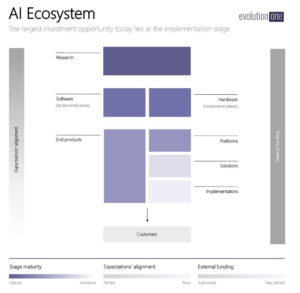Why AI investors don’t get it right
Investors have been putting billions of dollars into AI startups every year for several years now. But they’re focusing on the wrong type of play. The large number of AI startups they’ve been funding are building vertical solutions, often from scratch, putting themselves in competition with technology giants — a battle they will lose most of the time.
Meanwhile, there is an increasingly obvious misalignment between what corporate customers expect from AI and what’s currently available in the market
Therefore, both AI investors and founders would be better off focusing on the opportunities around AI implementation, an area where customers struggle most.
As per our previous article Don’t wait too long to invest in AI, there has been rapid growth in AI investing over the last 5 years, although it is starting to show signs of slowing. M&A transactions have been growing fast as well, increasing more than five-fold from 2013 to 2018 (115 in 2018 vs. 22 in 2013). What’s interesting, however, is that despite a huge amount of investment pouring into the AI space, we are also seeing a relative lack of large exits.
Most of the big tech firms are purchasing these startups at a fairly early stage and thus are buying them for their founding teams, or for the technology, rather than acquiring already established businesses.
An alternative strategy pursued by a substantial number of startups and investors funding those has been to focus on building vertical solutions, often starting at a platform level and then proceeding all the way to the end product, in the hopes to build a robust product company capable of competing with the largest technology players.
While this approach is bold enough to potentially deliver the sought-after home runs, the amount of investment required to compete with big tech players is often just too large for most startups. The tech giants are often eyeing investment horizons that are much longer than anything available to startups. The giants can also often leverage their existing mature businesses (such as cloud computing) to extract additional value from their AI products, reducing the need to directly monetise those — a luxury most startups will never have.
That’s not to say there isn’t a significant opportunity in the AI space for startups – on the contrary, the appetite for AI-infused products and services is rapidly increasing. Today, 42% of executives believe AI will be of critical importance within two years, according to Deloitte, and the number of mentions of AI on earnings calls has also skyrocketed in the last three years.
However, according to another report from PwC, only 4% of surveyed tech executives in 60 countries have successfully implemented AI, with many experiencing challenges in implementing AI within their organisations. Security issues, privacy concerns, lack of appropriate skills, and lack of understanding among employees about the technologies being adopted are commonly cited as key barriers to successful adoption. It’s also telling that, according to Gartner, when asked about the expectations around AI implementation, most CIOs today tend to emphasise cost optimisation and efficiency improvements, with only 4% focusing on using AI to gain additional business/capture new customers (which typically is a more powerful lever to drive technology adoption).
This creates a huge opportunity for both startups and investors. Instead of playing an unpredictable and dangerous game of competing with tech giants on their own turf, or hoping to build a piece of technology or product that would be attractive enough for the startup to be purchased in an acquihire, those willing to work to help customers implement existing AI products and to build specialised solutions on top of already highly capable platforms from big tech players would be solving a significant customer pain and would also find tech giants to be partners rather than competitors.
Identifying investment opportunities requires looking at the industry holistically. If you visualise the space as a series of “building blocks” (each defined as a specific niche in the ecosystem) that go all the way from initial research to selecting product platforms to implementation, the areas of opportunity become clear. Investors should evaluate the level of maturity of these blocks and any misalignment between customer expectations and the solutions being offered.
The largest opportunities will lie in the area with a low alignment of expectations with the downstream blocks, provided that the alignment of expectations among the upstream participants is decent. The yield and the size of the opportunity would also depend on the level of the maturity of the ecosystem in this area.

In the AI space today, there is plenty of funding available at all stages, but the feedback loop among the downstream players (specifically in the B2B segment) is malfunctioning. Investors that choose to focus on closing the gap between customers and products by funding companies working at the implementation stage stand a better chance of reaping consistently high returns compared to the rest of the market.
Based on a venturebeat article by Alex Stern and Eugene Sidorin.
